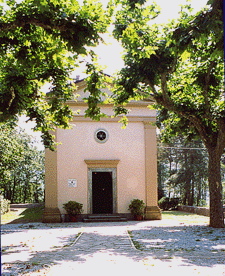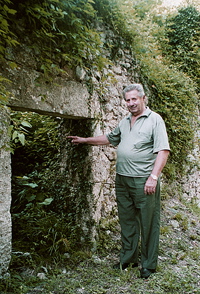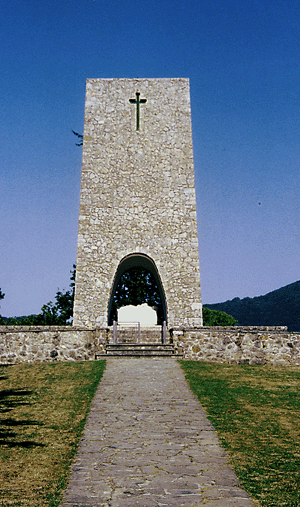A Tuscan Series By Paul Salsini |
A sweeping narrative from World War II to the turbulent 1990s |
About Sant'Anna di Stazzema

The tiny church at Sant'Anna di Stazzema.
Unlike the compact hill towns of Tuscany, which are often surrounded by walls, Sant'Anna di Stazzema consists of clusters of homes scattered over a hilltop. Some are close together, others far apart. It is located in the Apuan Alps near the western coast of Italy, north of Pietrasanta. The center of the village is the small church that contains a painting of Saint Anna and the Virgin Mary.
On August 12, 1944, the village suffered the second worst massacre at the hands of the Germans in Italy during World War II. Beginning early in the morning, SS troops raided houses and barns, slaughtering elderly men, women, children and cattle, and setting everything on fire. They put some thirty people into a stable and threw bombs inside. A woman was about to give birth in one house when the Nazis entered. They shot the woman, tore the baby from her womb, held it up and shot it.
They rounded up 140 people into the square in front of the church and despite the pleas of the parish priest, Father Innocenzo Lazzeri, they killed them all, including the priest. Then they pulled out benches from the church, put them around the bodies and set it all on fire.
The massacre lasted about four hours. Some 560 people were killed. Afterwards, the Germans sat down, ate their lunch and sang songs. One had a harmonica.
When word of the massacre spread, people in other parts of Italy were not only angry and terrified but also stunned. So high in the hills as to be almost inaccessible, Sant'Anna had been widely considered a safe haven. Several hundred refugees had recently arrived, almost doubling its population of 400.

Mauro Pieri escaped from a stable where his family and others were killed.
In the face of advancing Allied troops from the south of Italy, and with the end of the war nearing, the German troops at the time were retreating north to what was called their Gothic Line. Some historians believe the killings were in retaliation for the help some in Sant'Anna had been giving the Italian partisans who were sabotaging the German occupation. Others believe that the Germans' "scorched earth" policy was simply to terrorize.
In September 1944, the Allied War Crimes Commission conducted an investigation but inexplicably got the date of the massacre wrong (August 19 instead of August 12). It interviewed only a few witnesses plus a German soldier who wasn't at the scene and a neighboring priest who arrived later. Incredibly, ignoring the fact that many victims were women and children, it concluded: "It is doubtful whether this massacre would come under the heading of a 'war crime' as most of the villagers had been involved in partisan activity and had defied a German order to evacuate."
The Germans continued their destruction in northern Italy as the British and Americans approached. They rampaged through other villages, and from September 29 to October 1, 1944, in the worst massacre of the war, the SS pounded the Monte Sole area south of Bologna, killing 1,830 men, women and children and burning 420 houses.
Only a couple of dozen people live in Sant'Anna now, but every one has a story, every one has a relative who died. Enio Mancini was only six years old but remembers being saved by a young German soldier who told him and his family to flee into the woods. He is now the custodian of a museum honoring the victims in the former village schoolhouse. A large memorial has been built; beneath it are the remains of many of the victims.
One of the major mysteries in the years following the massacre was why Italy, even with its legendary slow pace of justice, did not initiate a war crimes trial. Those with conspiracy theories accuse Italian authorities of losing vital documents because post-war Italy did not want to confront its Fascist past (and Mussolini's treatment of Jews) and did not want to damage its relations with Germany. Indeed, in what could form the basis for a classic Italian film noir, nearly 700 reports about the massacre were not found until 1994. They were in a metal cabinet in the basement of the military court in Rome. The cabinet was turned to the wall.
In 2004, an Italian military tribunal finally began a trial against ten former Nazi soldiers involved in the massacre. After many delays, the tribunal in the summer of 2005 found the soldiers guilty of premeditated murder and sentenced them to life in prison. Since the men are now in the 80s and since Germany generally does not extradite its citizens, the verdict could be considered only a moral victory.
 The memorial to the 560 victims of the Nazi massacre. |